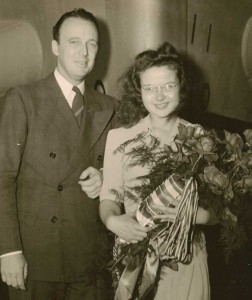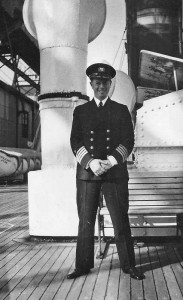True Tales: An Atlantic Odyssey Part 2
By George T. ComeauBelow is the second in a two-part series about the life and career of Captain Harold Winslow, one of Canton’s most decorated residents. Click here to read part 1.
As Captain Harold Winslow sat at his kitchen table, his boyhood home of Canton seemed so far away. It had been more than 25 years since he had been in his parent’s home on High Street. Most of his adult life was at sea, yet here on the stormiest night of his life he sat contemplating death and assessing his life as one of America’s most famous sea captains.
Thinking back, it was so clear to Winslow. The schooner, Gander Deal, had been blown more than 500 miles out to sea and wildly off course. The home port for the schooner had been New Town, on Bonavista Bay, Newfoundland. This small village was situated about 100 miles north of St. John’s and the Gander Deal crew had used the village money to purchase coal, oil, meat, tea and coffee for the winter survival of the 400 villagers. That winter storm of 1929 threatened to wipe out a year’s worth of fishing money and an entire generation of men.
Just about all of the able-bodied men of New Town were in the fleet that had been caught up in the epic storm. Of the nine vessels that left St. John’s in that storm, six were lost at sea. The gale descended upon the fleet from the northwest and scattered the ships in all directions. Like toys in a bathtub, they pitched and heaved at the ruthless hands of Mother Nature.
Deep in the cargo hold were Christmas toys — dolls and rocking horses for the children of the village. The men aboard the ship wondered if they would ever see their babies again. During the height of the storm the Gander Deal’s rudder had been torn away, and just about all of her rigging was in shreds. Mountainous waves broke over her stern, and the men huddled below. Captain Manuel Barbour, described as a “wiry little master,” was quoted as saying, “Another night and we’d have gone down with her, I guess.”
On December 5 at 4:30 a.m. the schooner sighted the Republic and sent up distress flairs. The 11 men were in an extreme condition, and as they lay in their sea-soaked bunks, frozen in time, they hoped the SS Republic would come to their aid. Three ships had already passed and hope was sinking fast. Nearly 1,000 miles off Cape Race, the Republic was heading home to New York City with passengers bound from Europe. First Officer F.S. Sobel sighted the flares and saw the sinking schooner. The Republic raced to the stricken ship and it was Winslow who selected eight volunteers that would rescue the fishermen.
At about 1,000 yards off the Gander Deal, Winslow lowered his lifeboat into the churning seas. Pulling alongside the schooner, the men jumped to safety just as the morning light was breaking across the horizon. Two of the fishermen were too weak to jump or climb and were in shock from the ordeal. The rescue made national news, and Captain Winslow was proclaimed a hero. And while he was a hero, in typical hero fashion he downplayed the event. “The sea was running high,” said Winslow, but he also reported that the gale had died down, minimizing his estimation of the danger of the rescue. That said, the Canton newspaper as well as the New York Times reported that it “was a glorious rescue and it is to the credit of Canton that one of her townsmen took an active part in it.”
Through the years, both Winslow and his close friend Captain Giles Stedman had participated in rescues at sea. And in all cases, both men were present when the other was being awarded a medal or extra compensation in recognition of their valor. So close was their relationship that when Winslow announced he would be married in 1935, Stedman was delighted to be his best man.
By 1935, Winslow was a well-established captain and the commander of the U.S. Lines’ American Banker. It may be likely that is where he met his bride to be. Miss Inge Thoennessen-Schuppe was the daughter of Mrs. Max Bendheim, a wealthy New York socialite and rumored baroness. Schuppe had studied in London, Paris, Dresden and Wiesbaden and was an elegant woman of stature and means.
Winslow stood at the altar of the Church of the Transfiguration in Manhattan. By his side was Captain Stedman — both men masters of massive ocean liners and now together — likely in uniform. The neo-gothic church, reminiscent of the English countryside, was a perfect storybook setting for the dashing captain and the European socialite. There was no honeymoon, however, as within hours of the ceremony Winslow departed New York in command of the American Banker, and his bride took up residence in his London Terrace apartment on West 23rd.
It had been an amazing life of this boy of Quincy and Canton. Winslow had risen through the ranks of the Navy, captained great ships, saved lives, and was declared a great hero. At one point he was second officer of the Leviathan — at the time the largest passenger ship in the world. And during his time on that great ship he served under his best friend Stedman.
At 45 he had been across the Atlantic hundreds of times, and yet he was now bound to land. Winslow likely had cancer, and reports were that he had suffered at least three hemorrhages within the last two years. Confined to port as a “stand-by master” or relief captain, depression set in.
On Tuesday, August 2, 1938, while Winslow’s ship, the Panama Pacific liner Pennsylvania was tied up at the Chelsea piers, he decided to take his own life. Inge Winslow had left to visit her mother. Sliding a chair up to the oven in his posh apartment, Winslow opened the enameled door. After blowing out the pilot lights, his hands trembled as he turned on five gas jets. Winslow bent over in his chair, stuck his head inside the oven, and simply went to sleep. The pain ended and so did the life of Captain Harold L. Winslow from Canton, Massachusetts.
The headlines across the nation the next day told the lurid details of finding the lifeless body and recounted Winslow’s heroics and authority over the seas. A syndicated photograph of Winslow and his wife ran across the pages of the Boston Traveller, and here in Canton, his parents, Charles and Anna, wept for the loss of their son.
It is likely, according to naval historian Bill Lee, that Stedman and Winslow would have “talked it over if something was to happen.” In other words, they confided their last wishes to each other. And Winslow’s last wish was to return to the sea. A funeral was held in New York at a 10th Avenue funeral parlor. A uniformed guard from the American Legion was sent from the Roosevelt Lines Post. Men who had served under Winslow were present, including Captain Harold Cunningham, the former commodore of United States Lines.
Stedman was devastated by the untimely death of his close friend and took a leave of absence to deal with the loss. Returning to his command aboard the ocean liner Washington, he sailed from New York on the last week of August 1938. On the 27th at 10:15 p.m., Stedman stood on the bridge of the 700-foot luxury ship and summoned his closest crewmembers — men who had served under Winslow.
The black hull cruised through the Atlantic on a perfect calm starlit evening. Just off the bridge was a door that opened onto the bridge wing — the narrow walkway extending over the ocean away from the hull of the ship. The men lined up and Stedman stepped outside into the southeasterly breeze.
Stedman held a small canvas bag in his hands and ordered the ship to slow down to a certain speed and to turn away from the light wind. Knowing when the current, the wind, and the speed was just right, Stedman cast the lightly tied canvas bag of ashes into the wind and spread his dear friend over the Atlantic Ocean. The Atlantic was the place that they both loved so dearly. The exact spot selected by Stedman is recorded on a chart presented to the family — in latitude 47, 11 north; longitude 37, 11 west, “at the crossroads of the Atlantic where the eastbound Fastnet track meets the westbound Bishop’s Track.” The final recognition to the man “where great ships will dip their bows in tribute to a beloved navigator.” As the ceremony ended, Winslow’s favorite song, “When the Dew is on the Rose,” was played softly. Stedman said a final prayer and simply said “farewell.”

Dorothy Winslow Copley at the dedication and launch of the USS Harold L. Winslow in 1943 (Courtesy of Faith Winslow Barry)
Five years passed, and the United States became embroiled in World War II. During the wartime buildup more than 2,700 Liberty ships were launched. Here in Canton, Dorothy Winslow decided to write to Washington to have a ship named for her uncle. On Saturday, October 16, 1943 the Winslow family gathered at the Bethlehem Shipyard in Baltimore, Maryland. At 4 p.m., Dorothy stepped to the bow of the sparkling new warship and broke the traditional bottle across the bow. The S.S. Harold Winslow slid down the gangway and once again a Winslow was at sea.
It was a great tribute to a heroic man who saved 11 lives so that they could travel home at Christmas. It may have also provided much-needed closure for this Canton family. The S.S. Winslow was decommissioned and sold in 1964. Converted to a floating warehouse along the Kenai Peninsula in Nikishka, Alaska, it is likely still on the water.
Special thanks for additional family research to Faith Winslow Barry of Deerfield, New Hampshire.
Short URL: https://www.thecantoncitizen.com/?p=19597











